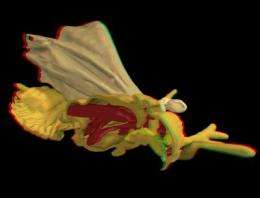For ever and ever: When the wedding flight never ends

German entomologists have now "resurrected" the fossil insect Mengea tertiara. Using high resolution micro-computer tomography the anatomy of an extinct insect was completely reconstructed three-dimensionally for the first time.
Its stay on this planet was actually meant to be a very short one. Male twisted-wing parasites (Strepsiptera) usually have a life span of only few hours. However, accidentally a specimen of Mengea tertiara, about the size of an aphid, became preserved for 'eternity': during its wedding flight about 42 million years ago it was caught in a drop of tree resin and subsequently almost perfectly conserved in a piece of amber.
PD Dr. Hans Pohl of Friedrich Schiller University Jena (Germany) calls this "a very exceptional stroke of luck." Together with colleagues from Jena, Hamburg and New York, the insect researcher at the Institute of Systematic Zoology and Evolutionary Biology with Phyletic Museum has now 'resurrected' the fossil insect: using high resolution micro-computer tomography (micro-CT) the anatomy of an extinct insect was completely reconstructed three-dimensionally for the first time.
The researchers did not only get a detailed and realistic impression of the external form of the extinct insect. "The micro-CT also allows us to look into the interior", Dr. Pohl stresses. Whereas the inner organs were destroyed during the process of petrification under high pressure, internal soft tissues are occasionally largely preserved in amber fossils.
About 80 percent of the inner tissues of the fossilized twisted-wing parasite were exceptionally well preserved, as revealed by the recent evaluation of the micro-CT data. Musculature, nervous system, sense organs, digestive and reproductive systems were displayed to the Jena scientists like an open book. With 3D-glasses the insect can be viewed in three dimensions. Only a few mouse clicks are needed to turn it around or to produce virtual sections.
"This leads to important insights in the phylogeny and evolution of these insects", Professor Dr. Rolf Beutel of the University Jena explains. Until today the placement of Strepsiptera in the phylogenetic tree of insects remained an enigma. "The females of these strange animals are almost always endoparasitic, i. e. live inside their hosts", Beutel continues. However, according to Beutel, the females of the analyzed species must have been free living. This conclusion is based on the simple shape of the external genitalia of the Mengea male. The males of species with females parasitizing in winged insects always have an anchor-shaped penis. "This firmly connects the males with the females, which are embedded in fast moving hosts such as for instance plant hoppers or bees." This specific docking mechanism is clearly missing in Mengea.
Moreover, the Jena research team could confirm the position of the extinct Mengea within the evolutionary tree. "These are ancestral predecessors of strepsipteran species existing today", says Dr. Pohl. Finding females and copulating was the only mission of the males during their extremely short life span. "This is clearly reflected by their anatomy", says the insect researcher. Highly efficient antennal sense organs and 'raspberry eyes' help to track the female. The flight apparatus and the genitalia were particularly well developed. In contrast to this, the mouth parts and the digestive tract are distinctly reduced compared to other insects. "The males were not able to ingest food, at least not in solid form", Professor Beutel concludes. It is possible that the intestine was filled with air, which improves the flying capacity of these tiny insects.
The Jena researchers will scan more amber insects in the near future. "This method has an enormous potential", Dr. Pohl says confidently. It not only allows a very detailed study of external and internal structures but is also non- destructive, in contrast to other techniques. Both aspects combined will guarantee an immense progress in the investigation of fossil and extant insects. Like Mengea other fossils will be preserved for critical investigations and re-evaluations of future scientists.
Provided by Friedrich-Schiller-Universitaet Jena

















